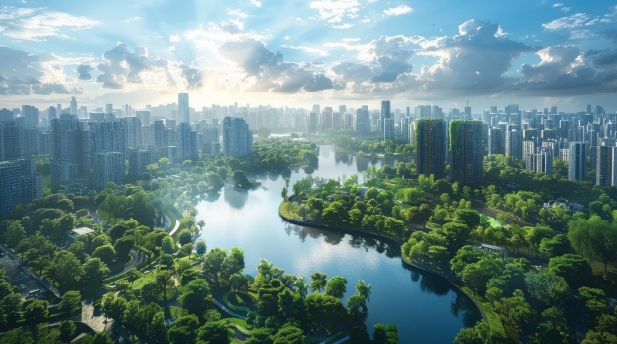In today’s rapidly urbanizing world, cities are expanding at an unprecedented rate, often at the expense of natural habitats. However, amidst the concrete and steel, the importance of maintaining and enhancing biodiversity within urban areas has become increasingly evident. Urban green spaces—parks, gardens, green roofs, and even street trees—play a crucial role in supporting biodiversity, which in turn benefits human well-being and environmental health. Steve Wentzel explores the multifaceted benefits of urban biodiversity, underscoring the need for more green spaces in our cities.
The Value of Urban Biodiversity
Urban biodiversity refers to the variety of living organisms found within city environments, including plants, animals, and microorganisms. Maintaining a diverse array of species in urban areas is essential for several reasons:
Environmental Health
- Ecosystem Services: Biodiverse green spaces provide numerous ecosystem services that are vital for urban environments. These include air and water purification, climate regulation, and soil fertility. Plants and trees absorb pollutants, reducing the urban heat island effect and improving air quality. Wetlands and green roofs help manage stormwater, reducing the risk of flooding and water pollution.
- Pollination and Pest Control: A diverse array of plants attracts pollinators like bees and butterflies, which are essential for the reproduction of many plant species, including food crops. Additionally, a balanced ecosystem with a variety of species will naturally regulate pests, reducing the need for chemical pesticides that can harm the environment.
- Climate Resilience: Biodiverse urban areas are more resilient to climate change. Diverse plant species can better withstand extreme weather conditions, and the presence of green spaces helps mitigate the impacts of heatwaves and heavy rainfall, contributing to the overall climate resilience of cities.
Human Well-Being
- Mental Health and Recreation: Access to green spaces has been linked to improved mental health and well-being. Natural environments provide a space for relaxation, recreation, and social interaction, reducing stress and promoting physical activity. Studies have shown that spending time in nature can alleviate symptoms of depression and anxiety, contributing to a healthier, happier urban population.
- Community and Social Cohesion: Green spaces serve as communal areas where people can gather, interact, and build social connections. These spaces foster a sense of community and belonging, which is crucial for social cohesion in urban settings. Events and activities held in parks and gardens bring diverse groups together, promoting inclusivity and cultural exchange.
- Educational Opportunities: Urban green spaces provide valuable opportunities for environmental education. Schools and community groups can use these areas to teach children and adults about biodiversity, ecology, and the importance of conservation. Hands-on learning experiences in natural settings can inspire future generations to become stewards of the environment.
Economic Benefits
- Property Values: The presence of green spaces tends to increase property values in urban areas. People are willing to pay a premium for homes and offices near parks and gardens, recognizing the quality-of-life benefits these spaces offer. This increase in property values can boost the local economy and generate additional tax revenue for cities.
- Tourism and Business: Well-maintained urban green spaces can attract tourists and boost local businesses. Iconic parks and gardens often become landmarks and destinations in their own right, drawing in visitors from near and far. This influx of tourists can support local hospitality, retail, and service industries, contributing to the economic vitality of urban areas.
Challenges and Solutions
Despite the clear benefits, maintaining and enhancing urban biodiversity faces several challenges:
- Space Constraints: Urban areas are often densely populated, with limited space for new green areas. Innovative solutions, such as green roofs, vertical gardens, and pocket parks, can help maximize the use of available space and integrate nature into the urban fabric.
- Funding and Maintenance: Establishing and maintaining green spaces requires financial resources and ongoing care. Public-private partnerships, community involvement, and government funding can provide the necessary support for the creation and upkeep of urban green areas.
- Awareness and Engagement: Raising awareness about the importance of urban biodiversity and encouraging community engagement are crucial for the success of green initiatives. Educational campaigns, citizen science projects, and participatory planning processes can all help involve residents in biodiversity conservation efforts.
Urban biodiversity is no longer just a luxury; it’s a necessity for the well-being of both people and the planet at large. Green spaces in cities provide a wide range of environmental, social, and economic benefits, making them indispensable for sustainable urban living. As cities continue to grow, it will become increasingly essential to prioritize the creation and preservation of biodiverse green areas. By doing so, we can ensure healthier, more resilient, and more vibrant urban environments for current and future generations.
In conclusion, the integration of green spaces within urban landscapes is a critical step toward enhancing biodiversity and improving the quality of life in cities. Policymakers, urban planners, and communities must work together to create greener, more sustainable urban environments that support both human well-being and environmental health. Through concerted efforts and innovative solutions, we can make our cities thriving havens of biodiversity and natural beauty.
